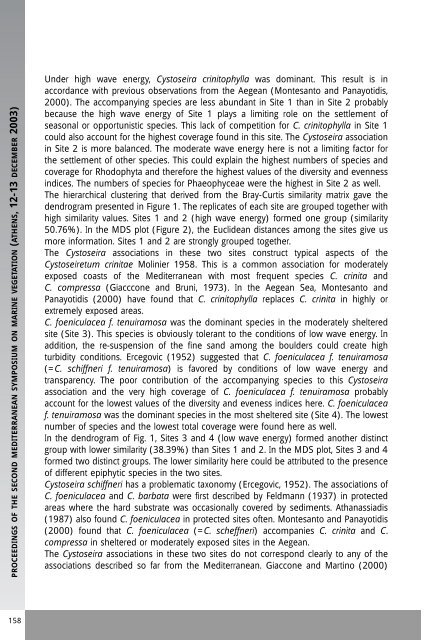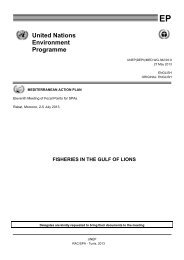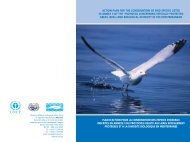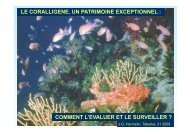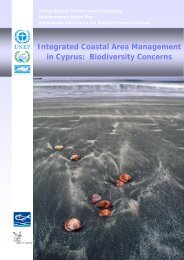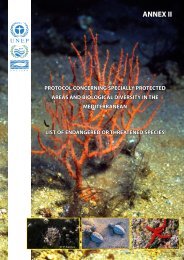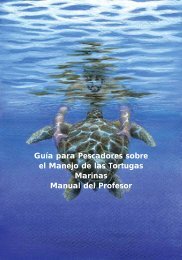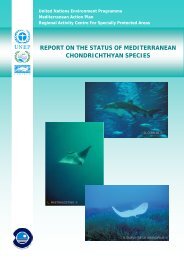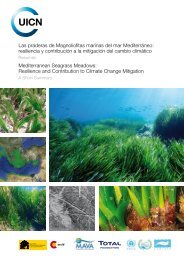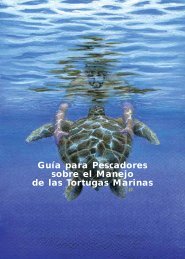Proceedings of the Second Mediterranean Symposium on Marine
Proceedings of the Second Mediterranean Symposium on Marine
Proceedings of the Second Mediterranean Symposium on Marine
You also want an ePaper? Increase the reach of your titles
YUMPU automatically turns print PDFs into web optimized ePapers that Google loves.
PROCEEDINGS OF THE SECOND MEDITERRANEAN SYMPOSIUM ON MARINE VEGETATION (ATHENS, 12-13 DECEMBER 2003)<br />
158<br />
Under high wave energy, Cystoseira crinitophylla was dominant. This result is in<br />
accordance with previous observati<strong>on</strong>s from <str<strong>on</strong>g>the</str<strong>on</strong>g> Aegean (M<strong>on</strong>tesanto and Panayotidis,<br />
2000). The accompanying species are less abundant in Site 1 than in Site 2 probably<br />
because <str<strong>on</strong>g>the</str<strong>on</strong>g> high wave energy <str<strong>on</strong>g>of</str<strong>on</strong>g> Site 1 plays a limiting role <strong>on</strong> <str<strong>on</strong>g>the</str<strong>on</strong>g> settlement <str<strong>on</strong>g>of</str<strong>on</strong>g><br />
seas<strong>on</strong>al or opportunistic species. This lack <str<strong>on</strong>g>of</str<strong>on</strong>g> competiti<strong>on</strong> for C. crinitophylla in Site 1<br />
could also account for <str<strong>on</strong>g>the</str<strong>on</strong>g> highest coverage found in this site. The Cystoseira associati<strong>on</strong><br />
in Site 2 is more balanced. The moderate wave energy here is not a limiting factor for<br />
<str<strong>on</strong>g>the</str<strong>on</strong>g> settlement <str<strong>on</strong>g>of</str<strong>on</strong>g> o<str<strong>on</strong>g>the</str<strong>on</strong>g>r species. This could explain <str<strong>on</strong>g>the</str<strong>on</strong>g> highest numbers <str<strong>on</strong>g>of</str<strong>on</strong>g> species and<br />
coverage for Rhodophyta and <str<strong>on</strong>g>the</str<strong>on</strong>g>refore <str<strong>on</strong>g>the</str<strong>on</strong>g> highest values <str<strong>on</strong>g>of</str<strong>on</strong>g> <str<strong>on</strong>g>the</str<strong>on</strong>g> diversity and evenness<br />
indices. The numbers <str<strong>on</strong>g>of</str<strong>on</strong>g> species for Phaeophyceae were <str<strong>on</strong>g>the</str<strong>on</strong>g> highest in Site 2 as well.<br />
The hierarchical clustering that derived from <str<strong>on</strong>g>the</str<strong>on</strong>g> Bray-Curtis similarity matrix gave <str<strong>on</strong>g>the</str<strong>on</strong>g><br />
dendrogram presented in Figure 1. The replicates <str<strong>on</strong>g>of</str<strong>on</strong>g> each site are grouped toge<str<strong>on</strong>g>the</str<strong>on</strong>g>r with<br />
high similarity values. Sites 1 and 2 (high wave energy) formed <strong>on</strong>e group (similarity<br />
50.76%). In <str<strong>on</strong>g>the</str<strong>on</strong>g> MDS plot (Figure 2), <str<strong>on</strong>g>the</str<strong>on</strong>g> Euclidean distances am<strong>on</strong>g <str<strong>on</strong>g>the</str<strong>on</strong>g> sites give us<br />
more informati<strong>on</strong>. Sites 1 and 2 are str<strong>on</strong>gly grouped toge<str<strong>on</strong>g>the</str<strong>on</strong>g>r.<br />
The Cystoseira associati<strong>on</strong>s in <str<strong>on</strong>g>the</str<strong>on</strong>g>se two sites c<strong>on</strong>struct typical aspects <str<strong>on</strong>g>of</str<strong>on</strong>g> <str<strong>on</strong>g>the</str<strong>on</strong>g><br />
Cystoseiretum crinitae Molinier 1958. This is a comm<strong>on</strong> associati<strong>on</strong> for moderately<br />
exposed coasts <str<strong>on</strong>g>of</str<strong>on</strong>g> <str<strong>on</strong>g>the</str<strong>on</strong>g> <str<strong>on</strong>g>Mediterranean</str<strong>on</strong>g> with most frequent species C. crinita and<br />
C. compressa (Giaccc<strong>on</strong>e and Bruni, 1973). In <str<strong>on</strong>g>the</str<strong>on</strong>g> Aegean Sea, M<strong>on</strong>tesanto and<br />
Panayotidis (2000) have found that C. crinitophylla replaces C. crinita in highly or<br />
extremely exposed areas.<br />
C. foeniculacea f. tenuiramosa was <str<strong>on</strong>g>the</str<strong>on</strong>g> dominant species in <str<strong>on</strong>g>the</str<strong>on</strong>g> moderately sheltered<br />
site (Site 3). This species is obviously tolerant to <str<strong>on</strong>g>the</str<strong>on</strong>g> c<strong>on</strong>diti<strong>on</strong>s <str<strong>on</strong>g>of</str<strong>on</strong>g> low wave energy. In<br />
additi<strong>on</strong>, <str<strong>on</strong>g>the</str<strong>on</strong>g> re-suspensi<strong>on</strong> <str<strong>on</strong>g>of</str<strong>on</strong>g> <str<strong>on</strong>g>the</str<strong>on</strong>g> fine sand am<strong>on</strong>g <str<strong>on</strong>g>the</str<strong>on</strong>g> boulders could create high<br />
turbidity c<strong>on</strong>diti<strong>on</strong>s. Ercegovic (1952) suggested that C. foeniculacea f. tenuiramosa<br />
(=C. schiffneri f. tenuiramosa) is favored by c<strong>on</strong>diti<strong>on</strong>s <str<strong>on</strong>g>of</str<strong>on</strong>g> low wave energy and<br />
transparency. The poor c<strong>on</strong>tributi<strong>on</strong> <str<strong>on</strong>g>of</str<strong>on</strong>g> <str<strong>on</strong>g>the</str<strong>on</strong>g> accompanying species to this Cystoseira<br />
associati<strong>on</strong> and <str<strong>on</strong>g>the</str<strong>on</strong>g> very high coverage <str<strong>on</strong>g>of</str<strong>on</strong>g> C. foeniculacea f. tenuiramosa probably<br />
account for <str<strong>on</strong>g>the</str<strong>on</strong>g> lowest values <str<strong>on</strong>g>of</str<strong>on</strong>g> <str<strong>on</strong>g>the</str<strong>on</strong>g> diversity and eveness indices here. C. foeniculacea<br />
f. tenuiramosa was <str<strong>on</strong>g>the</str<strong>on</strong>g> dominant species in <str<strong>on</strong>g>the</str<strong>on</strong>g> most sheltered site (Site 4). The lowest<br />
number <str<strong>on</strong>g>of</str<strong>on</strong>g> species and <str<strong>on</strong>g>the</str<strong>on</strong>g> lowest total coverage were found here as well.<br />
In <str<strong>on</strong>g>the</str<strong>on</strong>g> dendrogram <str<strong>on</strong>g>of</str<strong>on</strong>g> Fig. 1, Sites 3 and 4 (low wave energy) formed ano<str<strong>on</strong>g>the</str<strong>on</strong>g>r distinct<br />
group with lower similarity (38.39%) than Sites 1 and 2. In <str<strong>on</strong>g>the</str<strong>on</strong>g> MDS plot, Sites 3 and 4<br />
formed two distinct groups. The lower similarity here could be attributed to <str<strong>on</strong>g>the</str<strong>on</strong>g> presence<br />
<str<strong>on</strong>g>of</str<strong>on</strong>g> different epiphytic species in <str<strong>on</strong>g>the</str<strong>on</strong>g> two sites.<br />
Cystoseira schiffneri has a problematic tax<strong>on</strong>omy (Ercegovic, 1952). The associati<strong>on</strong>s <str<strong>on</strong>g>of</str<strong>on</strong>g><br />
C. foeniculacea and C. barbata were first described by Feldmann (1937) in protected<br />
areas where <str<strong>on</strong>g>the</str<strong>on</strong>g> hard substrate was occasi<strong>on</strong>ally covered by sediments. Athanassiadis<br />
(1987) also found C. foeniculacea in protected sites <str<strong>on</strong>g>of</str<strong>on</strong>g>ten. M<strong>on</strong>tesanto and Panayotidis<br />
(2000) found that C. foeniculacea (=C. scheffneri) accompanies C. crinita and C.<br />
compressa in sheltered or moderately exposed sites in <str<strong>on</strong>g>the</str<strong>on</strong>g> Aegean.<br />
The Cystoseira associati<strong>on</strong>s in <str<strong>on</strong>g>the</str<strong>on</strong>g>se two sites do not corresp<strong>on</strong>d clearly to any <str<strong>on</strong>g>of</str<strong>on</strong>g> <str<strong>on</strong>g>the</str<strong>on</strong>g><br />
associati<strong>on</strong>s described so far from <str<strong>on</strong>g>the</str<strong>on</strong>g> <str<strong>on</strong>g>Mediterranean</str<strong>on</strong>g>. Giacc<strong>on</strong>e and Martino (2000)


